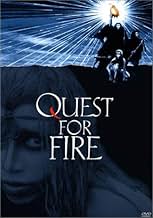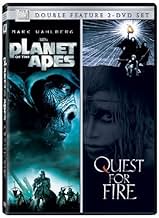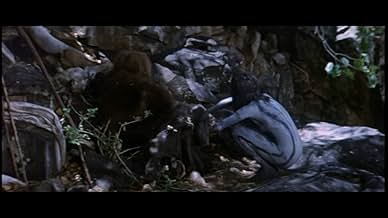IMDb रेटिंग
7.3/10
25 हज़ार
आपकी रेटिंग
अपनी भाषा में प्लॉट जोड़ेंThis story takes place in prehistoric time when three tribesmen search for a new fire source.This story takes place in prehistoric time when three tribesmen search for a new fire source.This story takes place in prehistoric time when three tribesmen search for a new fire source.
- निर्देशक
- लेखक
- स्टार
- 1 ऑस्कर जीते
- 11 जीत और कुल 8 नामांकन
Nicholas Kadi
- Gaw
- (as Nameer El-Kadi)
Franck-Olivier Bonnet
- Aghoo - The Ulam Tribe
- (as Frank Olivier Bonnet)
Joy Boushel
- The Ulam Tribe
- (as Joy Boushell)
फ़ीचर्ड समीक्षाएं
I recall when this film was released. If memory serves, the hype concerned the efforts to turn an elephant into a mastodon using make-up and an actress running around nude. In other words, the film in my mind fell into the 'One Million Year BC' category and I ignored it.
Later, I learned who Annaud was and admired 'The Name of the Rose' for its direction, its translation of a difficult book and its effort at realism. Finally, I rented 'Quest for Fire' on DVD and saw it on the big home screen. (In fact, I watched it several months ago and I'm commenting now because it remains in my mind.)
Experts can quibble about the realism. But for me, this film makes an intelligent and credible effort to present a world of 80,000 years ago. In this, it raises good questions about who we are as a species. Human genetic code has not changed in that time and any one of the beings portrayed would be perfectly capable of using a computer as I'm doing now. Nonetheless, they lived in a world without numbers, without prices, without trade, without written language and without means to create fire. Everyone alive today had an ancestor who survived those conditions. 'Quest for Fire' is a must-see for anyone curious about the human condition.
Later, I learned who Annaud was and admired 'The Name of the Rose' for its direction, its translation of a difficult book and its effort at realism. Finally, I rented 'Quest for Fire' on DVD and saw it on the big home screen. (In fact, I watched it several months ago and I'm commenting now because it remains in my mind.)
Experts can quibble about the realism. But for me, this film makes an intelligent and credible effort to present a world of 80,000 years ago. In this, it raises good questions about who we are as a species. Human genetic code has not changed in that time and any one of the beings portrayed would be perfectly capable of using a computer as I'm doing now. Nonetheless, they lived in a world without numbers, without prices, without trade, without written language and without means to create fire. Everyone alive today had an ancestor who survived those conditions. 'Quest for Fire' is a must-see for anyone curious about the human condition.
I caught this in Boston back in 1981. They played it in the biggest cinema they had in 70mm and in stereo sound. I had only the slightest idea of what it was about but it sounded interesting. When I realized it was a caveman movie I almost left, but the beautiful wide screen cinematography kept me in my seat. Slowly it worked on me and by the end I was mesmerized.
There's not really much of a plot--the caveman discover fire and different sexual positions--and there's no dialogue that we could understand but it didn't matter. The whole cast was excellent--especially Ron Perelman and Rae Dawn Chong (who had guts to do this). Their whole performances had to be done using some foreign language and body movement but they pulled it off. I heard Anthony Burgess was called in to develop the language used and coach the cast in how to use it. The cinematography is just breath-taking and the prehistoric animals look realistic all the way. I can't exactly say why I loved this movie but I did.
20th Century Fox deserves credit for actually acquiring the film and releasing it. Naturally it bombed badly here in the US but it seems I'm not the only one who likes it--when I mention it to friends I just get a blank look back. I haven't seen it since 1981 but it's never left me. Try to see it on a big screen TV. I give it an 8.
There's not really much of a plot--the caveman discover fire and different sexual positions--and there's no dialogue that we could understand but it didn't matter. The whole cast was excellent--especially Ron Perelman and Rae Dawn Chong (who had guts to do this). Their whole performances had to be done using some foreign language and body movement but they pulled it off. I heard Anthony Burgess was called in to develop the language used and coach the cast in how to use it. The cinematography is just breath-taking and the prehistoric animals look realistic all the way. I can't exactly say why I loved this movie but I did.
20th Century Fox deserves credit for actually acquiring the film and releasing it. Naturally it bombed badly here in the US but it seems I'm not the only one who likes it--when I mention it to friends I just get a blank look back. I haven't seen it since 1981 but it's never left me. Try to see it on a big screen TV. I give it an 8.
"Quest for Fire" (1981 - 100 minutes), under Jean-Jacques Annaud direction and written by Gérard Brach, was based on the book of J. H. Rosny. The movie develops a travel in time showing one of the biggest conquest of human kind: the domain of fire. It's a 80 thousand years ago beautiful drama. The Ulan tribe lives nearby a natural source of fire. When the fire went out, three members of the tribe have to search for a new flame. After several days of walking and having to face many dangerous situations like wild animals, down temperatures and even cannibal tribes, they found the Ivakas, a more evolved human group that had already discovered how to "make" fire. With locations in Kenya, Scotland, Island and Canada, the movie was based on scientific knowledge, showing convincing habitats and characters. The preparation work of the actors body language was done by the Anthropologist Desmond Morris and Anthony Burgess took care of the "talking" of these human ancestors. Almost an Anthropology documentary, this excellent movie shows at the end a scene that suggests the "discovery of love" between male and female. Absolutely unforgettable.
This is an extremely overlooked film many people should learn about. First, it tells you a very complex story without a single line of dialog successfully.
Second, the story is universal: Every civilization on earth can pick up this film and understand it, because it goes to the most basic, primitive issues of a species (mainly, survival). Third, it makes the beginning of man interesting. Fourth, it reminds us we were once as savage as any other animal on earth.
Fifth, it's like no other movie you've seen before. That one I can guarantee you.
Second, the story is universal: Every civilization on earth can pick up this film and understand it, because it goes to the most basic, primitive issues of a species (mainly, survival). Third, it makes the beginning of man interesting. Fourth, it reminds us we were once as savage as any other animal on earth.
Fifth, it's like no other movie you've seen before. That one I can guarantee you.
Raw and at times brutal, this story follows three primitive warriors who make a cross-country journey in search of that most precious of natural elements ... fire. In prehistoric times, having fire meant survival from the cold and protection from predators.
In this film, facial gestures, hand movements, general body language and mannerisms of the characters are all consistent with conclusions about early man, as a result of thorough anthropological research. In lieu of modern language the film's dialogue consists of some 350 invented words and sounds, also based on research. In addition, an important part of the film is attention to detail in costumes and makeup, for which the film won several awards. All of these technical cinematic elements combine to create a reasonably accurate visual and audio impression of mankind as it existed some 80,000 years ago.
As you would expect, the film is shot entirely in rugged, remote locations, resulting in landscapes that are stunningly beautiful. Background music is generally low-key and ethereal, like what you might hear in a sci-fi film. There's lots of flute sounds, which reinforce the simplicity of the time period.
For all its technical achievements, this film's main weakness may be the screenplay. When you take away the artifacts of modern life, you're very limited in the kind of story you can tell. And that clearly is the case here, with a plot that drones on with a monotony and repetition that can be tedious, and at times difficult for some viewers.
Although the story's entertainment value may be marginal, "Quest For Fire", with its low tech cinematic style, is interesting not only for its technical elements but also for its over arching theme of modern human's continuity with prehistoric man, based on the element of fire.
In this film, facial gestures, hand movements, general body language and mannerisms of the characters are all consistent with conclusions about early man, as a result of thorough anthropological research. In lieu of modern language the film's dialogue consists of some 350 invented words and sounds, also based on research. In addition, an important part of the film is attention to detail in costumes and makeup, for which the film won several awards. All of these technical cinematic elements combine to create a reasonably accurate visual and audio impression of mankind as it existed some 80,000 years ago.
As you would expect, the film is shot entirely in rugged, remote locations, resulting in landscapes that are stunningly beautiful. Background music is generally low-key and ethereal, like what you might hear in a sci-fi film. There's lots of flute sounds, which reinforce the simplicity of the time period.
For all its technical achievements, this film's main weakness may be the screenplay. When you take away the artifacts of modern life, you're very limited in the kind of story you can tell. And that clearly is the case here, with a plot that drones on with a monotony and repetition that can be tedious, and at times difficult for some viewers.
Although the story's entertainment value may be marginal, "Quest For Fire", with its low tech cinematic style, is interesting not only for its technical elements but also for its over arching theme of modern human's continuity with prehistoric man, based on the element of fire.
क्या आपको पता है
- ट्रिवियाBoth Ron Perlman and Everett McGill suffered frostbite; luckily they were able to heal completely. Despite the working conditions, they both enjoyed making the film.
- गूफ़The movie is set 80,000 years ago, and appears to show the one tribe has made pottery. Fragments of ancient pottery found in southern China date back to only 20,000 years, making them the world's oldest known pottery. However, the vessel shown is actually a dried hollow gourd.
- भाव
[first lines]
Title Card: 80,000 years ago, man's survival in a vast uncharted land depended on the possession of fire. / For those early humans, fire was an object of great mystery, since no one had mastered its creation. Fire had to be stolen from nature, it had to be kept alive - sheltered from wind and rain, guarded from rival tribes. / Fire was a symbol of power and a means of survival. The tribe who possessed fire, possessed life.
- इसके अलावा अन्य वर्जनAll UK versions are cut by 8 secs and are missing a shot of a wolf on fire.
- कनेक्शनFeatured in À propos de 'La guerre du feu' (1981)
टॉप पसंद
रेटिंग देने के लिए साइन-इन करें और वैयक्तिकृत सुझावों के लिए वॉचलिस्ट करें
- How long is Quest for Fire?Alexa द्वारा संचालित
विवरण
- रिलीज़ की तारीख़
- कंट्री ऑफ़ ओरिजिन
- भाषाएं
- इस रूप में भी जाना जाता है
- Quest for Fire
- फ़िल्माने की जगहें
- उत्पादन कंपनियां
- IMDbPro पर और कंपनी क्रेडिट देखें
बॉक्स ऑफ़िस
- बजट
- $1,25,00,000(अनुमानित)
- US और कनाडा में सकल
- $2,09,59,585
- दुनिया भर में सकल
- $2,09,62,615
- चलने की अवधि1 घंटा 40 मिनट
- रंग
- पक्ष अनुपात
- 2.35 : 1
इस पेज में योगदान दें
किसी बदलाव का सुझाव दें या अनुपलब्ध कॉन्टेंट जोड़ें



![Bande-annonce [OV]](https://m.media-amazon.com/images/M/MV5BZTg3YWU0MTMtMDk1Mi00M2Y4LWFiODgtYzFhOTAyMWRjYWY2XkEyXkFqcGdeQXRyYW5zY29kZS13b3JrZmxvdw@@._V1_QL75_UY281_CR74)





























